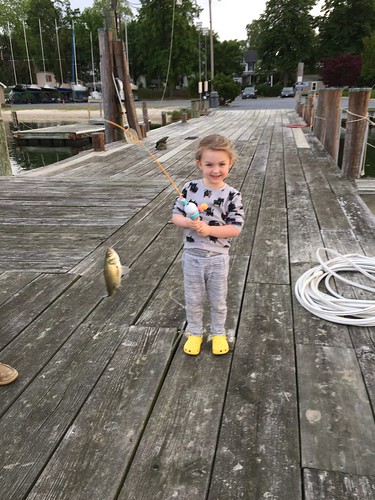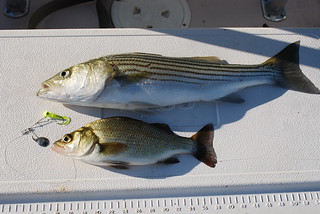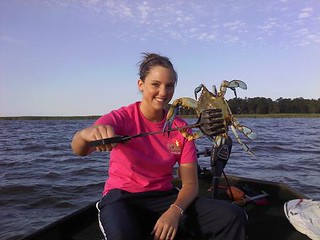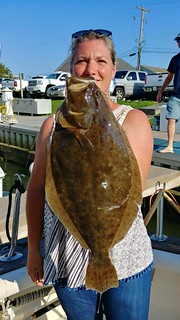Maryland Fishing Report: August 8

Poppy Lewis is all smiles with her white perch that she caught all by herself. Photo by Keith Lockwood
It is often said that summertime is for kids, and truer words could not be spoken this month.
August will be gone in a flash so don’t delay getting any youngsters you know out or near the water to enjoy some fun fishing.
Two fish that are always ready to accommodate our young anglers are bluegill sunfish and white perch. Kids need plenty of action to keep them interested and these two species can provide that if you take the steps to ensure success.
It is pretty hard to beat worms and a bobber for bluegills at a local pond or fishing under a dock with grass shrimp and a simple one-hook bottom rig for white perch.
And for you photographers out there, the Maryland Natural Resource photo contest wraps up this month. Enter your best shots showcasing Maryland’s great fishing and outdoors by midnight Aug. 31.
Winners will be featured in the 2019 wall calendar; additional prizes include cash and park passes. Enter today!
Forecast Summary: Aug. 8-14
This upcoming week in Chesapeake Bay will be defined by warm waters and poor water clarity resulting from the high river flows. The bright spot is the recent oxygen conditions, with the bay experiencing some of the best on record. Since most of the water column has been recharged with oxygen, expect striped bass to move deeper toward cooler waters during daylight hours.
As of July 27, the coolest waters from surface to bottom are from the Susquehanna Flats down to Still Pond. The temperature break appears to be near the Gunpowder Neck area, with cooler areas north of this point and warmer waters south. The current water temperatures are 83 degrees at Annapolis, 84 degrees at Gooses Reef and 84 degrees at Point Lookout. Remember, rockfish will avoid waters above 84 degrees!
From the Bay Bridge north, most areas have adequate oxygen from surface to bottom. For anglers, continue to seek the best combination of clear, cool, oxygenated waters. This means fishing deep or early in the morning. There will be above average tidal currents all week as a result of the upcoming new moon Aug. 12
For the full weekly fishing conditions summary and more detailed and up-to-date fishing conditions in your area of the bay, be sure to check out Click Before You Cast.
Upper Chesapeake Bay
A good portion of the floating debris that was so prominent last week has slowly worked its way down the bay by wind and tide. It has choked coves and harbors, littered shorelines and washed up into marsh areas. A very high tide may cause it to drift elsewhere. All boaters are on high alert as they keep a diligent watch for floating debris.
The Conowingo Dam flows are still high but nothing like last week. Locals reports found good fishing in the mouths of the creeks feeding into the lower Susquehanna River and catching a mix of striped bass and smallmouth bass. Most of the floating debris has moved out of the region and locals are just dealing with stained water conditions.
Water temperatures are climbing back up again into the low 80s due to warm daytime air temperatures and bright sunlight. Some striped bass have moved off the shoal areas near Tolchester and holding near 20-foot edges at Swan, Love and Podickory points and some of the knolls and shoals east of Baltimore Harbor. Chumming is still very popular but live lining spot is accounting for larger fish and fewer throwbacks. The spot can be found near the Bay Bridge in about 15 feet of water and the southwest side is a very great place to gather up some live spot on bloodworm baits.
There has been plenty of action around the Bay Bridge piers and live lining spot, small eels or jigging have been the preferred methods. The striped bass tend to be holding in 25 feet of water. White perch are also holding close to the piers in 15 feet of water or less and can be caught on bloodworms or grass shrimp on a bottom rig or small jig head.
Fishing for white perch in the tidal rivers has been exceptional lately. Large white perch are plentiful this year in most areas and offer some fun and fruitful fishing opportunities. Casting small spinners and spinnerbaits along shallow shoreline structure or fishing deeper with bottom rigs baited with bloodworms or grass shrimp is the ticket. Channel catfish are also very abundant in the upper portions of the bay and its tidal rivers, and cut bait tends to be the best bait option. There is also a shallow water fishery for striped bass in the early morning hours along the shorelines of the bay and tidal rivers. Topwater lures and crankbaits tend to be favorite choices for casting.
Striped bass tend to be spread out over a wide area this week. They are holding as deep as possible during the day looking for the coolest water that still has enough dissolved oxygen so they can breathe. Surface water temperatures have climbed back into the low 80s and the salinity values are still low due to runoff. Floating debris will continue to be a problem in the middle bay region this week so be careful out there.
Scattered schools of striped bass can be found along main channel edges, but it will take some poking around with depth finders to find them. Most any edge has the potential to hold some striped bass in about 20 to 25 feet of water. They are holding as deep as they can as long as there is sufficient dissolved oxygen at those depths. Some locations worth checking out include the Brickhouse Bar off Kent Island, Thomas Point, Tilghman Point in Eastern Bay, the False Channel and the Diamonds, as well as the shipping channel edge near Parkers Creek.
Chumming is of course popular but with the availability of live spot, live lining can be a much better way to catch a larger size striped bass and eliminate a lot of throwbacks. Spot can be found on the inside of Hacketts Bar and just east of Black Walnut Point in the Choptank River. The lower sections of other tidal rivers in the region may also produce spot, look for hard bottom areas in about 15 feet of water. Pieces of bloodworms, #4 or #6 hooks and just enough sinker is all you need to catch them. A large trash can or live tank will ensure keeping them lively on the trip to your fishing destination.
White perch fishing has been stellar in the region’s tidal rivers and creeks. They can be found in relatively shallow water along shoreline structure in the early morning or late evening hours. Light tackle and small spinnerbaits or spinners is a great way to catch them. Those holding deeper near dock piers can be caught on grass shrimp on a simple one hook bottom rig. The abundance of large white perch this year presents some wonderful fishing opportunities for small boat and shoreline anglers, both young and old.
The shallow water striped bass fishery is alive and well, but it means getting out on the water before dawn for the best fishing. The action tends to close down once the sun clears the horizon. Topwater lures are a favorite when fishing over grassy areas and jerkbaits can be used in slightly deeper waters near shoreline structure.
Striped bass fishing for those chumming or live lining spot at the rock piles north of Point Lookout, the mouth of the Potomac River and the steep channel edge near St. Georges Island, has been good this week. Bluefish in the three-quarter-pound size range are now a major player.
Trolling can be a good option in the lower bay region for a mix of bluefish and striped bass. Gold spoons or red and green hoses tend to be the most popular choices. The steep channel edge in the Potomac from Swan Point to Colton Point has been a good place to troll as well as the mouth of the Patuxent River up to the Broomes Island area. In the general area above the Target Ship there is a catch-and-release fishery for large red drum. Most are being caught on large spoons behind inline weights. Spanish mackerel tend to be holding south in Virginia waters, but a few are being caught in the Pocomoke Sound area by trolling small spoons.
There is much talk about whether cobia will ever show up in the Target Ship area – although there may be a stray fish here and there, anglers will have to go south to catch them. Most of the action tends to be below Windmill Point in Virginia and southeast to the Eastern Shore of Virginia. Most are chumming and either drifting fresh cut baits to the back of the chum slick or allowing live eels to hold there. A fair portion of the cobia being caught do not measure up to the minimum size of 40 inches.
Fishing for a mix of croaker, spot and white perch has been very good in the lower Patuxent River, Cornfield Harbor as well as the Tangier and Pocomoke sounds. Shore-bound anglers have been enjoying extremely good fishing for spot in the evenings at the fishing pier under the Route 4 Bridge over the Patuxent River. The spot are mostly being caught on bloodworms and the perch and croakers on peeler crab or bloodworms.
Recreational crabbing continues to improve as the summer months move on. The best catches are occurring in the lower bay region, with the eastern side of the bay being a standout. Middle bay crabbers are managing to catch a half to full bushel per outing and catches up to a half bushel in the upper bay. If using chicken necks, fresh is very important and there is no doubt that razor clams are catching the best. Most crabs tend to be in 12 feet of water or less.
Vacation season at Deep Creek Lake is in full swing and dodging boats and jet skis will be necessary while trying to find a peaceful place to fish. Slipping back into coves during the early morning hours is a good tactic to fish shoreline structure and grass for largemouth bass. Chain pickerel are often about to provide entertainment as well. Drifting live minnows along deep grass and rocky edges is a good way to target a mix of walleye, smallmouth bass and yellow perch that are holding deep. Trout can be found by slow-trolling nightcrawlers or minnows along the dam face in deep water.

John Mullican and his fishing buddy Steve Peperak recently took advantage of ideal stream conditions catching and releasing many beautiful wild brown trout; with little insect activity, they chose to fish small, weighted nymphs. Photo by John Mullican
The upper Potomac is still unruly due to flooding and stained waters, but smaller stream and creeks in the western region are in good shape with healthy water flows that spur on trout activity.
Largemouth bass fishing continues with a typical summer mode of behavior of night feeding in the shallows and lounging around in the cool shade during the daytime that sounds like a great way to spend the hot summer months. One has to be up early to find bass in the shallower areas, where topwater lures can be the most exciting way to fish for them. Buzzbaits, frogs and poppers are great lures to use in the shallow grassy areas. These topwater baits will also attract the attention of northern snakeheads in many of the tidal rivers and creeks. The tidal creeks of the Potomac River are where they got their start years ago but the tidal areas of the lower Eastern Shore are quickly catching up in regards to expanding populations.
As the sun rises in the sky and the sun beats down upon the waters, largemouth bass retreat to deeper and cooler waters where they can find shade under overhead grass mats, sunken wood, old docks or fallen treetops. This is time to break out the weedless soft plastics, stick worms and drop them right in front of lounging bass. The pickups tend to be rather subtle, so it pays to back off a second or two when you feel that twitch before striking.
Crappie can be found deep near structure this time of the year. In tidal rivers this often means marina docks, fallen treetops and bridge piers. Crappie populations in lakes and reservoirs tend to be found near dam faces, deep sunken wood and in some impoundments managed by the Maryland Department of Natural Resources, old Christmas trees are weighted and sunk in the deeper areas. It will take a depth finder to find them and crappie can often be seen clustered around the recycled trees. Small jigs or minnows under a slip bobber are a classic way to target them.

Just about everyone went fishing in the tournament’s opening days, and one crew brought in a 881-pound blue marlin. Photo by Angel Willey
The big event this week is the White Marlin Open, which has grown to unbelievable dimensions in regards to the winnings. This year’s purse has reached an estimated $5.45 million with 382 boats competing from ports as far north as Barnegat Inlet in New Jersey to Rudee Inlet in Virginia. Boats may fish anywhere as long as they are within 100 miles of Ocean City Inlet. Boats get to fish three out of five days the tournament is open.
For those wishing to pursue a little less competitive fishing experience, there is plenty of fun fishing to be had. Kingfish are being caught in the surf on pieces of bloodworms along with small bluefish and flounder on cut bait.
At the inlet, sheepshead are being caught at the South Jetty on sand fleas, flounder on strip baits of squid as well as minnows and white Gulp mullet baits. At night striped bass and bluefish can be caught by drifting live spot, small eels or cut bait in the inlet and Route 50 Bridge area.
Flounder fishing has been very good in the channels leading toward the inlet and back bay areas. Water clarity has been good which is always important to targeting this ambush predator; they need to be able to see baits from a distance.
Outside the inlet there is a lot of exciting fishing action that does not involve the tournament. A mix of king mackerel, large Spanish mackerel, Atlantic bonito, small dolphin and bluefish are being found at some of the offshore shoal areas. Trolling with spoons, cedar plugs and small plastic skirted lures has been an effective way to catch them.
Large flounder are being found at the wreck and reef sites along with some sea bass. The best sea bass catches this week are coming from some of the deeper sites. Those headed out near the shelf are catching tilefish, sea bass and a few large tautog.
More than 300 boats were out at the canyons early this week and although fish were caught it was rather limited. Bluefin and a few yellowfin tuna are being caught by chunking and jigging with butterfly jigs at Massey’s Canyon, Poorman’s and even the Jackspot. Several large dolphin were brought in and there were reports of blue marlin.
“There is nothing that attracts human nature more powerfully than the sport of tempting the unknown with a fishing line.” – Henry Van Dyke
 ABOUT THE AUTHOR Keith Lockwood has been writing the Fishing Report since 2003 and has had a long career as a fisheries research biologist since 1973. Over the course of his career he has studied estuarine fishery populations, ocean species, and over a decade long study of bioaccumulation of chemicals in aquatic species in New Jersey. Upon moving to Oxford on the eastern shore of Maryland; research endeavors focused on a variety of catch-and-release studies as well as other fisheries related research at the Cooperative Oxford Laboratory. Education and outreach to the fishing public has always been an important component to the mission of these studies. Keith is an avid outdoorsman enjoying hunting, fishing, bird dogs, family and life on the eastern shore of Maryland.
ABOUT THE AUTHOR Keith Lockwood has been writing the Fishing Report since 2003 and has had a long career as a fisheries research biologist since 1973. Over the course of his career he has studied estuarine fishery populations, ocean species, and over a decade long study of bioaccumulation of chemicals in aquatic species in New Jersey. Upon moving to Oxford on the eastern shore of Maryland; research endeavors focused on a variety of catch-and-release studies as well as other fisheries related research at the Cooperative Oxford Laboratory. Education and outreach to the fishing public has always been an important component to the mission of these studies. Keith is an avid outdoorsman enjoying hunting, fishing, bird dogs, family and life on the eastern shore of Maryland.





 1-888-373-7888
1-888-373-7888 233733
233733